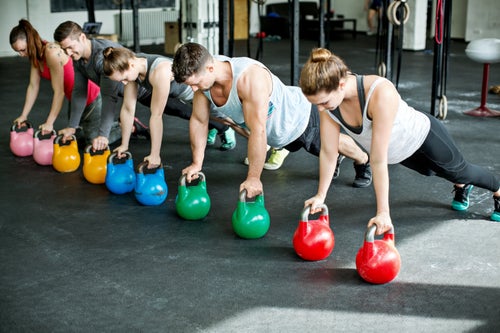If you’re short on time when you head to the gym, picking up a kettlebell during your workout could be hugely beneficial.
Why? Because you’re getting a cardio and strength workout at the same time.
A study published in the Journal of Strength and Conditioning Research in 2015 proved just how valuable these weights can be.
People who used a kettlebell as part of their workouts for four weeks experienced a 6% increase in their VO2 max score (the amount of oxygen your body can use when exercising at high intensity). In the same study, those who just did a circuit training class over that period didn’t get a VO2 max increase.
Jim Crossley, co-founder F45 Kingston told HuffPost UK: “Kettlebells provide a great variety of exercises and provide a full body workout with a single piece of equipment.
“We use them in nearly all of the F45 workouts – they’re very popular.”


What are they?
Kettlebells are round weights with a single handle.
“Kettle bells are a form of free weight that allows for a range of movement patterns that a conventional free weight - such as a dumbbell or barbell - would not allow,” said Matt Leeman, PT and professional triathlete and sponsored by ETE TriCamps.
What parts of your body do they work out?
Crossley said kettlebells can work every part of your body.
“You can swing it with a hip hinge, working your posterior chain (the glutes, hamstrings, and lower back),” he said. “You can press it overhead to work arms and shoulders, and you can hold to your chest while you squat with it to work your lower body.
“The shape and grip of the kettlebell means that each of these exercises can be more challenging than doing the same thing with a dumbbell or barbell.”
Why are kettlebells beneficial for us?
Leeman explained: “Exercises that use multiple muscle groups expend more energy than those that only isolate one muscle.
“These complex movements also help increase a physical efficacy of athletic and explosive movements, as most sports will require the use of multiple muscles in a movement pattern.
“You also don’t need a wide range of weight increments to have an effective workout, one kettlebell can be enough to get it done.”
What kettlebell workouts should we try?
1. Kettlebell swings
Use a single kettlebell held with both arms. “The swing is a hip hinge movement,” said Crossley. “So do not squat or use your arm strength to raise the kettlebells.”
2. Sumo squat and row
Crossley explained: “From a wide squat, hold a single kettlebell hanging down with both hands. Keep your back straight and head up, and at the top of the squat bring the kettlebell up to chin height, keeping your elbows, hands and kettlebell in a straight horizontal line at the top.”
3. Deadlift
Crossley’s final workout is slightly more intense: “Stand with feet hip distance apart, holding a kettlebell in each hand, arms extended downwards. Hinge backward at the hips, keeping shoulders back and chest up, knees slightly bent until the kettle bells touch the floor. Straighten up by pushing the hips forward.”
How should you hold the kettlebells?
The handle is a form of upside ‘U’ shape, enabling the weight to be gripped at different angles and with an “over or underhand” grip.
The way you hold the weight may depend on the type of activity you are doing.
Crossley offered some suggestions of how to hold the equipment, depending on the workout you are doing:
When swinging you can change hands at the top of the swing easily at the point the kettlebell becomes ‘weightless’.
You can flip the kettlebell over your hand so the weight rests on your raised arm at the top and then squat.
When you press the kettlebell overhead you can let the kettlebell hang below your hand, or to make it more challenging try pressing the kettlebell while keeping the weight above your hand.
You can hold a pair of kettlebells in a ‘rack’ in which your arms are raised to shoulder height, elbows bent, with the weights resting on your upper arms above the elbow and handles in your hands just below your chin. With the kettlebells in this position you can perform squats, lunges or duck walks.
You can use two kettlebells on the floor as static ‘handles’ to perform press-ups with a greater range of motion, tricep dips and shoot-throughs.